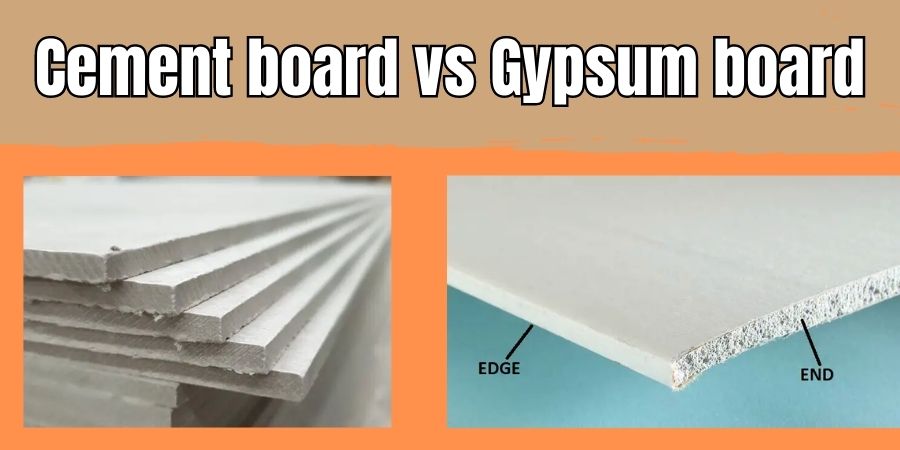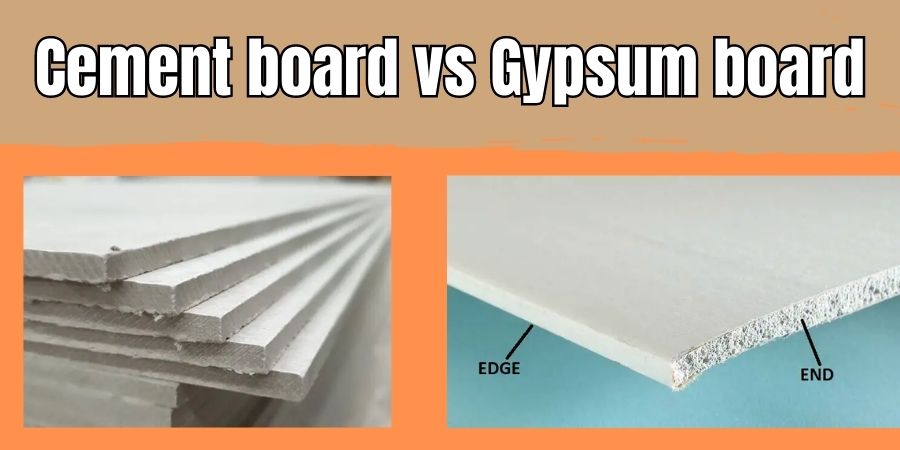When it comes to choosing between cement board and gypsum board, both have their pros and cons depending on your specific needs. Here’s a rundown of the key differences between the two.
Table of Contents
Cement Board: The Sturdy Option

Cement board is a popular choice for areas that are exposed to moisture, such as bathrooms and kitchens, as it is highly resistant to water and mold. It is made from a mixture of cement and fiber, which gives it its sturdiness and durability. Cement board is also fire-resistant, making it a safer option for walls and floors.
Another advantage of cement board is that it is stronger than gypsum board, which means it can support heavier materials such as tiles. It is also ideal for outdoor use, as it can withstand extreme temperatures and weather conditions.
However, the downside of cement board is that it is heavier and harder to cut than gypsum board, which can make installation more difficult. It also tends to be more expensive than gypsum board.
Gypsum Board: The Lightweight Option

Gypsum board, also known as drywall, is a popular choice for interior walls and ceilings as it is lightweight and easy to install. It is made from gypsum plaster that is sandwiched between two layers of paper or fiberglass. Gypsum board is also more affordable than cement board.
One advantage of gypsum board is that it is easier to cut than cement board, which makes it a faster and simpler option for installation. It is also easier to sand and paint than cement board, which can make it a more attractive option for finished walls.
However, gypsum board is not as sturdy as cement board and is more susceptible to water damage, making it a poor choice for areas with high moisture levels.
Which Should You Choose?
- If you are looking for a sturdy and durable option that can withstand moisture and support heavy materials, cement board may be the better choice.
- However, if you are looking for a lightweight and affordable option that is easy to install, gypsum board may be the way to go.
FAQs
Q: Which is cheaper, fiber cement board or gypsum board?
A: Generally, gypsum board is cheaper than fiber cement board.
Q: What are the disadvantages of cement board?
A: Some of the disadvantages of cement board include its weight, which makes it difficult to handle and install, and its tendency to crack if not installed properly. Additionally, cement board can be more expensive than other types of building materials, such as gypsum board.
Q: Can cement board be used on a ceiling?
A: Yes, cement board can be used on a ceiling. However, it is important to make sure that the ceiling can support the weight of the cement board, as it is a heavy material.
Q: What is cement board used for?
A: Cement board is commonly used as a backing for tile, stone, or brick veneer in wet areas such as bathrooms, kitchens, and laundry rooms, as well as for exterior cladding systems like siding, soffits, and roofs. It is also used as a base for stucco and other exterior finishes, as well as for fireproofing and soundproofing applications.
Differences Between Cement Board vs. Gypsum Board

Despite the boards looking alike and having important purposes in the construction industry, they have significant differences that anyone considering a renovation or building project should consider.
Durability
Cement board has a mixture of cement and cellulose fiber. This combination makes the board extremely durable. It withstands UV rays, strong winds, and pounding rain. On the flip side, gypsum boards damage easily, making them a terrible product for exterior construction projects.
Installation
When installing cement boards, contractors need to use a heavy-duty circular saw or a similarly strong cutting tool. Thanks to the cement and cellulose combination, cement boards are heavy. On the other hand, contractors only need a utility knife to cut gypsum, and the lightweight board is easy for one person to lift and put into place.
Drywall stays in place with taper-head drywall screws, but keeping cement board in place requires heavy-duty decking screens or strong roofing nails.
Because drywall is lightweight and easy to use, many people do their drywall work. Cement board work should be completed by professionals who have the skills and tools to do the work safely and correctly.
Water Resistance
Consumers can purchase cement boards that are water-resistant or waterproof. The interior gypsum core is not waterproof, but some products have moisture-resistant paper on the outside of the gypsum board.
Fire Resistance
Regardless of the thickness of gypsum panels, they are all fire-resistant. Standard half-inch drywall has 30-minute fire resistance. However, thicker panels and those made with more fiberglass have longer fire ratings. The higher-rated products cost more than standard drywall.
Some manufacturers make varying degrees of fire-resistant panels. Some panels have two-hour fire ratings, while others have one-hour ratings. This means that the panels will withstand fire for one or two hours.
Some gypsum panels have a fire rating of up to four hours, while most residential and commercial properties have standards that require one or two hours.
Cement boards also have a significant fire rating. The standard for cement boards is two hours.
Uses for Cement Boards vs. Gypsum Boards
Because cement boards can prevent mold and mildew thanks to their water-resistant qualities, contractors use them in bathrooms, kitchens, and basements. It is also the product of choice to use under tiles in wet areas.
Gypsum board is a terrible choice to use in wet areas and behind or under the tile. It weakens when it becomes wet, which can cause walls to collapse. Tiles can be too heavy for gypsum board, and should only be placed on strong cement board after it is secured to the studs.
Some people do use gypsum board in their bathrooms and basements, but only in the areas that will not have direct water exposure. The best places for gypsum board are living areas like family rooms and bedrooms where humidity and moisture is not a factor.
Flooring
Gypsum boards are not strong enough to be used as flooring, but a cement board with a minimum thickness of 16 millimeters can withstand people walking on it repeatedly. Many contractors use cement boards as the base for tile floors.
Noise Reduction
Between cement board and drywall, cement board provides the best noise reduction. Both products help reduce noise, but the thickness and weight of the cement board reduce more noise.
Manufacturers build noise-reducing drywall, which has more than gypsum in the panels. The soundproof drywall also has viscoelastic and ceramics to block soundwaves.
Surfaces
Cement boards have two sides. The rough side helps tiles, adhesives, and grout stay put, while the smooth side can function as an exterior wall. Gypsum has smooth sides that allow contractors and DIYers to connect them with smooth joint compound. The smooth sides of gypsum and cement board can accept paint and primer.





